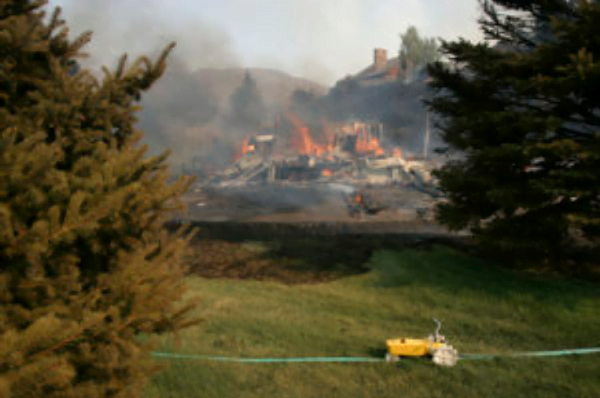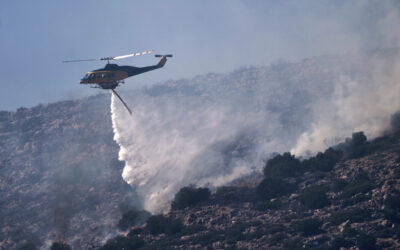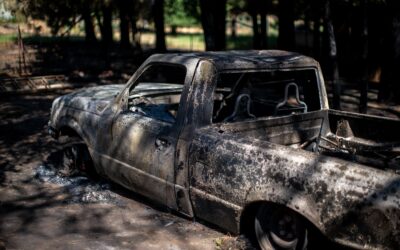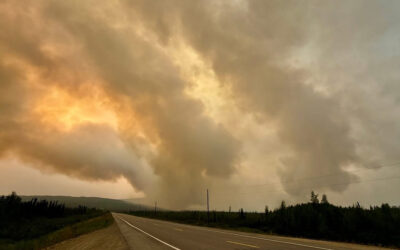Learn the major difference between a TRA and a safety zone

By Jerry Burke and Kelley Gouette | FireRescue Magazine Volume 7, Issue 9
During wildland/urban interface (WUI) fires, it’s become an all-too-common occurrence for firefighters to take greater risks when defending civilians and assets. Although no fire agency suggests taking extraordinary risks, firefighters have a natural tendency to push the envelope when lives and structures are threatened.
Of course, a “can-do” attitude must be tempered with real-time fire behavior forecasting and the mindset that threatened assets should be defended with acceptable risk to firefighters. But as we all know, conditions that are safe one moment can change rapidly, posing a threat as fire behavior shifts. Firefighters must anticipate changes in fire behavior and respond accordingly, taking appropriate action to avoid injury.
It is the responsibility of all firefighters to constantly assess their own safety and the safety of those around them by maintaining a heightened level of situational awareness (SA) in the WUI. SA requires personnel to:
- Understand their assignment;
- Maintain a positive accountability of subordinates;
- Remain aware of adjoining resources and their assignments;
- Remain aware of current and forecasted weather and fire behavior;
- Maintain radio communications with subordinates and supervisors; and
- Establish identified temporary refuge areas and escape routes to safety zones.
Safety Zones & Escape Routes
When identifying escape routes, consider the distance between the tactical work area and the safety zone, and the amount of time it will take to travel between the two. Travel time should be commensurate with the rate of fire spread. As resources move within their tactical work area, escape routes must be reevaluated and reestablished as needed.
The size of a safety zone is determined by the observed maximum flame height. The Incident Response Pocket Guide (IRPG) states that distance between the firefighter and the flames should be a minimum of four times the maximum continuous flame height. Distance separation equals the radius from the center of the safety zone to the nearest fuels. Convective heat from wind or topographic influences will increase this distance requirement.
Safety zones that meet the IRPG criteria are rarely present in the WUI environment, where housing density and small parcel sizes preclude the existence of large, open areas. It’s also difficult to construct adequate safety zones in the WUI without destroying residential improvements; however, there are WUI-specific areas that can function as safety zones:
- Any area without flammable vegetation (rock slide, bodies of water, wet meadows, cleared open space, greenbelts)
- Large parking lots
- School/athletic fields
- Parks with open, grassy areas
- Previously burned areas with no flammable overstory (canopy)
Where the TRA Fits In
The temporary refuge area (TRA) concept is somewhat new to the WUI firefighting arena; however, it has been adopted by FIRESCOPE and is currently part of the California Department of Forestry and Fire Protection (CAL FIRE) WUI training curriculum.
In short, anything that protects firefighters from radiant or convective heat can be considered a TRA; therefore, if an escape route to a safety zone becomes compromised, firefighters should use a TRA until it’s safe to move to the safety zone or safely return to work. Keep in mind, however, that a TRA is not a replacement for an identified safety zone; it is merely a temporary, short-term solution that firefighters can use when needed.
TRA Considerations
Unlike a safety zone that may be some distance away from the tactical work area, a TRA should always be identified on site so that firefighters can quickly secure short-term relief from unexpected flare-ups or adverse changes in fire behavior.
The major difference between a TRA and a safety zone: TRAs may not provide continuous, adequate safety and protection because of changing fire conditions or extreme fire behavior, therefore a TRA always requires another planned tactical action. Firefighters who take shelter in a TRA must have a contingency plan in place in the event they are forced to abandon their position. For example, firefighters taking temporary refuge inside a structure must plan their next move in case the structure begins to burn and they can’t remain inside. This may mean moving to an apparatus, sheltering behind a wall or rock outcropping or finding another suitable heat barrier.
Potential WUI TRAs include:
- Large turnouts, cul-de-sacs or parking lots
- On-site greenbelts, meadows, pastures, large lawns
- Lee side of structures
- Inside apparatus
- Inside structures
When using a TRA, keep all personnel together, and continuously account for all crewmembers. Provide fireline supervisors with situation details and an accurate description of the TRA location and how to access it, and request ground and/or air support and rescue resources, if needed.
When the threat subsides, evaluate personnel for injuries and provide treatment as necessary. Update fireline supervisors of the crew’s status and any additional resource needs. When safe to do so, re-engage the fire or move to the safety zone.
What to Use: Apparatus or Structure?
As a TRA, an apparatus can provide tactical mobility as well as some protection from radiant heat, blowing embers, dust, smoke and other hot gasses. With the exception of tactical mobility, a structure can provide the same.
When determining whether to use an apparatus or structure as a TRA, consider:
- Fire behavior, intensity and rate of spread
- Vegetation clearance around the apparatus or structure
- Fuel type (grass vs. heavy fuels) and loading
- Duration of exposure to heat and direct flame impingement
- Proximity to concentrated heat sources
- Proximity to adverse topographic features (drainages, chimneys etc.)
When preparing an apparatus for use as a TRA, park facing the direction of the escape route, and run the engine at a high idle (1,000 rpm if available, so that thick smoke, soot and dust don’t bog down the engine and possibly stall it out.). Close all windows, and deploy fire shelters over windows, if necessary. Turn on all lights, including headlights and emergency lights, so that the crew can find its way to the apparatus and others can see the apparatus,and be ready to disconnect deployed hoselays. Take structure fire PPE, SCBA and drinking water into the cab, and be prepared to move the vehicle to the safety zone as conditions permit. Lastly, notify your supervisor that the vehicle is being used as a TRA.
Preparing a structure for use as a TRA is very similar: First, close all windows and doors, and remove flammable materials from windows. If drapes are present, close or remove them if they’re made of flammable material. Turn on all interior and exterior lights, even during the daytime. Apply a Class A foam or gel on the structure’s exterior (time permitting), and fire out around the structure (if appropriate). Deploy charged hoselines from the apparatus and garden hoses through openings on the least involved side. Take structure fire PPE, SCBA and drinking water into the structure and move to a location furthest from the fire. Identify alternate exits and notify your supervisor that you’re using the structure as a TRA.
Keep in mind that using an apparatus or structure as a TRA requires another planned tactical action in the event that conditions deteriorate. The apparatus operator must be prepared to move to another TRA or use an escape route to withdraw to a safety zone when safe to do so. If conditions inside the structure deteriorate, firefighters must be prepared to leave the structure and move to another TRA or use an escape route to withdraw to a safety zone when safe to do so.
Other considerations/precautions when using a vehicle/structure TRA: above-ground fuel storage, power lines, ditches and bridges.
Important: Do not use a structure or apparatus TRA as a substitute for identifying and utilizing viable escape routes and safety zones. Only use a structure or apparatus TRA if escape routes to safety zones have been compromised.
Your Exit Strategy
A review of near-miss reports and fatal fires reveals that many firefighters have abandoned or ignored suitable TRAs while engaged in structure defense or while en route to a safety zone, rather than waiting in a TRA until conditions allowed for safe access to a safety zone. Remember: Firefighting in the WUI is dangerous, and as such, it always requires a planned exit strategy. That strategy should always include the following:
- Employ a tactical maneuver to avoid injury; move away from the fire.
- Move to an identified TRA.
- Withdraw along an escape route.
- Move into an established safety zone.
Sidebar: Define Our Terms
- Escape routes are identified routes used to withdraw from a tactical work area to a pre-determined safety zone or temporary refuge area.
- A safety zone is a pre-planned area of sufficient size and suitable location that is expected to protect personnel and apparatus without deploying fire shelters.
- A temporary refuge area (TRA) is a pre-identified area where firefighters can immediately take refuge for temporary shelter and short-term relief without deploying a fire shelter in the event that access to an established safety zone is compromised.




